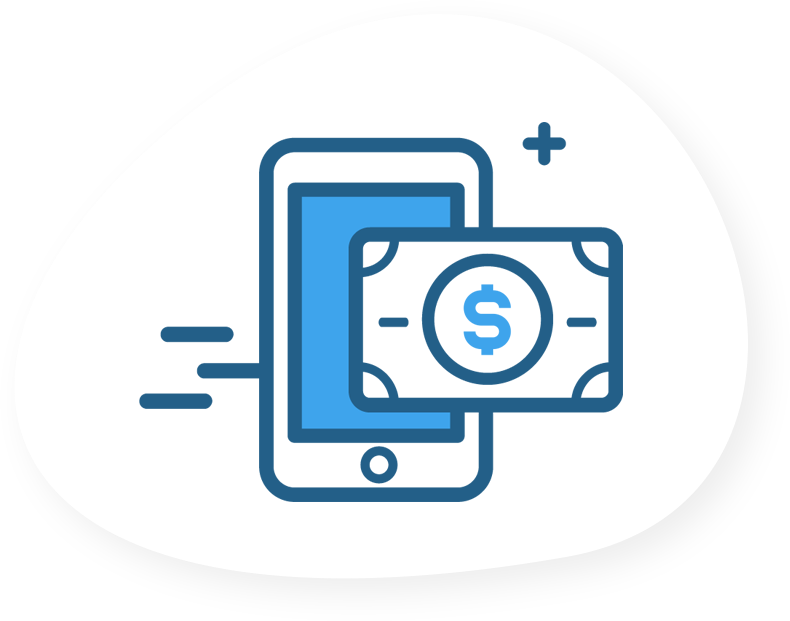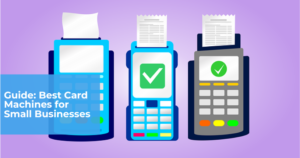A healthy business is often centred around positive cash flow and well organised accounts. But this wouldn’t be possible without efficient invoice management, that keeps on top of both expected incomings and all outgoings.
Whilst tedious, processing company invoices is one of the most significant parts of your SME’s cash flow. Any minor act of neglect can lead to problems, causing a decrease in your capital – which is why invoice systems for small businesses should be considered.
In this article, we’ve explained what invoice management is and why it’s important, how to organise paper and digital invoices, why you should be taking advantage of automated invoicing, and our top tips for sending effective invoices.
What is invoice management?
As a small business you’ll regularly send and receive bills for services or goods sold, so strong invoice management is essential. This is the internal processing and organisation of all payment documentation, and refers to the way you store information, whether within spreadsheets, physical files, or a cloud-based portal.
The process involves:
- Receiving an invoice from a third party.
- Validating it as legitimate.
- Paying the supplier.
- Noting the payment in company records.
The difference between invoices and receipts
While invoices and receipts are both payment-related documents, they are issued at different stages of the transactional journey and serve different purposes. We’ve outlined how to identify each.
What is an invoice?
An invoice is a document issued to a customer detailing an amount of money owed for goods and/or services. When issuing an invoice, you’ll need to provide a breakdown of the total costs and any relevant business details. It’s worth noting that invoicing isn’t always necessary, especially if your small business accepts payment instantly (i.e. you manage a shop, café, or restaurant).
What is a receipt?
Unlike an invoice, which requests payment for goods and services, a receipt is issued after payment has been received as proof of completion.
How to organise invoices
We’ve explained why it’s important to efficiently organise your invoices, and advised on the steps you should follow to maximise effectiveness.
What is the right invoice system for your business?
In the past few years, the adoption of invoice management software has changed the way businesses carry out their accounting management tasks. Companies acquire a faster and more efficient way to manage audits, bills, tax preparation, banking, and payroll through accounting software.
There are three primary invoice management systems, so choosing the right one for your business is essential. Moreover, various payment plans work for separate projects; it is necessary to find the most adapted payment schedule by talking to your client beforehand.
“Businesses that switched to cloud accounting have experienced a 15% boost in revenue.”
Flexi, 2021
3 payment schedule options to consider:
-
Interim Invoice
As a small business owner, you have a smaller financial capability. If you cannot afford to pay external providers at once, you can ask for the payments to be split into small instalments at precise intervals. These intervals can be when small tasks are completed or based on a specific timeframe.
NB: In the end, clients usually ask for a conclusive invoice summarising the prior invoice details.
-
Recurring Invoice
This is the best billing strategy as it guarantees a healthy cash flow. Recurring invoices are usually adopted when you have a long-lasting business relationship, and your invoice software automatically generates your bill.
NB: The billing becomes a part of your client’s weekly or monthly practice and should secure on-time payments.
-
Final Invoice
To summarise the finished project, you should send a final invoice to your client, providing that you had sent your provisional invoices throughout the process. Here, you must mention details such as 1) If your interim invoices had been previously paid, and 2) Construct a list of any outstanding amounts.
NB: Even if fully paid, it is best to send a final invoice at the end of each project or month, clearing all the prior bills
Good invoice management is vital for your company’s credibility; start invoicing completed jobs and setting up a clear payment schedule for your projects.
Why is invoice organisation important?
There are a number of key reasons why it’s important to organise your invoices and receipts, including simplifying the auditing process, ensuring you get paid for all goods and services provided, and keeping track of all outgoings.
Invoice organisation: step-by-step
We’ve outlined the simple steps you can follow to develop an effective and efficient invoice organisation process:
- Include detail
It’s important to include as much detail as possible when creating invoices, including date sent, customer ID, goods/service name, requested amount, and document reference number. This helps to improve clarity for both seller and buyer. - Store chronologically
Storing invoices in date order will make it much easier to access old data and records instantly, whether you’re auditing the last year or checking over a recent anomaly. - File immediately
Filing all invoices immediately will improve overall organisation, and help to keep all important data and information safe. - Prioritise simplicity
Develop a filing system that can be understood across your entire business. This is especially important if you anticipate growth, and need to explain company processes to new employees.
Physical invoice managemeny
While paper invoices are becoming less common, some small businesses still manage their finances with physical documentation. If you still issue paper invoices, it’s important to take the following into account:
- Print two copies of each invoice (one for your client and one for your own reference).
- Separate receivables from payables and match invoices with receipts upon payment. This helps you to keep track of what has been paid and what is due.
- Record all accounting information and notes in a designated journal.
- Store unprocessed and unmatched invoices/receipts separately, so you don’t miss any outstanding documents.
- Consider making digital copies of invoices and receipts, for internal referencing.
Digital invoice management
Managing and tracking your invoices digitally can improve overall business efficiency, Steps to follow include:
- Choose invoicing software that complements your business structure and the processes already in place. SimplyPayMe allows you to create, store, and track all invoices within your own personal portal. SimplyPayMe also allows you to add your logo and own T&C’s to invoices!
- Implement business-wide file naming standards, to improve organisation. This will allow you to identify each invoice at a glance.
- Separate all processed and unprocessed invoices, to ensure outstanding documents are highlighted. Within the SimplyPayMe app, you are able to set up payment reminders that chase outstanding invoices for you.
- Create colour-coded tags for each invoice to make navigation and identification easier.
- Depending on your business needs, consider cloud software that lets you share data with unlimited colleagues.
How has invoice management evolved?
Like many other aspects of business, invoice management has evolved over time and seen a digital shift in recent years; many SMEs are opting to move away from paper documentation in favour of the efficiency and reliability that comes with computerised software.
The reality is that there aren’t many small businesses that regularly communicate through letters and written notices; attaching an invoice to an email is easier than issuing a physical document and provides dated evidence of delivery.
Automated invoice platforms and software solutions
Spending countless hours combing through accounts can cost your business time and money, so being able to automate this process can be incredibly useful. Rather than having to manually issue a new invoice at the point of sale (or manually respond to each received invoice with payment), automated invoicing uses software that instantly creates a unique document for each transaction.
Automated/digital invoicing vs physical invoicing
We’ve outlined the reasons why your small business should consider adopting digital/automated processes, as opposed to physical invoicing:
- Leveraging the cloud
As your business grows, it can become more complex to manage mounding invoices and payments. Going digital allows you to access data via the cloud, send invoices straight from a job site, and more efficiently manage cash flow. - Saving on business costs
Introducing digital invoicing allows you to manage your accounts remotely, from anywhere. This negates the need for an expensive office space and printing supplies. - Improving business efficiency
Rather than you or your accountant manually spending time updating spreadsheets and processing invoices, automated software issues the relevant documentation without the need for human involvement and updates your records instantly. - Reducing human error
It’s only natural for human error to creep into your accounts if you’re having to manually input data for each invoice. Automating this process removes this risk and guarantees greater accuracy of data entry. - Ensuring archives are accessible
Organising your invoices and receipts within a digital system allows you to easily retrieve archived documents that would otherwise likely be stored in a buried physical folder.
The middle ground: invoice scanners
While digital invoicing is largely preferable, it’s not always feasible when processing accounts payable; some clients may prefer to send paper invoices while others favour electronic.
Fortunately, an invoice scanner lets you store traditional paper bills and documents in the cloud. Using scanning software, you are able to extract important data and information from the physical copy to create a digitised version. All information is effortlessly stored within your payment portal.
- Download document scanning software to your smartphone.
- Capture your paper invoice within the invoice scanner app, making sure all relevant details are included.
- The captured data will be shared within your payment partner and stored within your personal portal.
So, what are the best invoicing tools available?
Today, many financial tools exist in the market, making it easy for you to choose the best invoice management system suited to your specific needs and enterprise level. Small businesses, specifically, can find themselves experiencing fast phases of growth, which is why they should start investing in these tools now.
Here are a few of the best packages suited for your business:
SimplyPayMe provides an all-in-one mobile invoicing and payments service for SMEs without recourse to multiple systems or software. SPM also offers paperless invoicing (SMS, email, …), easy creation of your invoices and quotes, sends recurring billing, delivers a high-performing database, and secures payments and updates.
Wave is a cloud-based invoicing software that serves SMEs. The invoicing tool allows small businesses to create, customise, send, and track invoices in one place.
Xero is accounting software that allows unlimited users. You can create designed invoices, set up recurring invoices, and automate invoice payment reminders.
QuickBooks allows you to organise business finances in one place, create and send custom receipts and invoices, schedule recurring payments, and transact in multiple currencies.
Top tips to manage your invoices
To conclude, we’ve outlined the key things to remember every time you issue a new invoice and review your management processes:
- Ensure correct customer details are obtained before issuing any documentation.
- Clearly display your payment details on every invoice.
- Agree all payment terms in advance, and state on each invoice.
- Back up your invoice records in case of corruption or loss of data.
- Establish an invoicing schedule for large projects or retained clients.
- Regularly monitor the effectiveness of your accounts retrievable processes.
- Consider implementing incentives for quick payments (and late fees for slow payments).
For even more expert insight into managing payments as a small business, check out the latest from us over on our blog.












